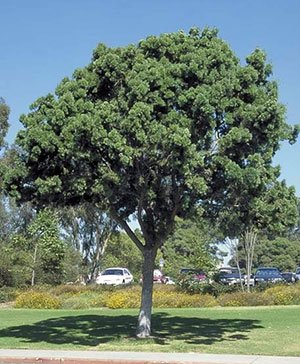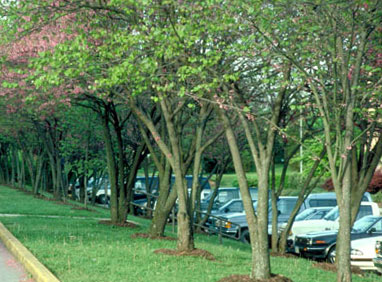Planting Trees for Energy Savings

Weeping podocarpus, Podocarpus gracilior is an evergreen tree best suited for central and south Florida. ©UF/Edward Gilman.
Did you know that your landscape can affect the temperatures inside your home? With careful planning and design, you can "go green" and create an energy-saving landscape.
Planting the right trees in the right place can help you save energy in your home year-round. Trees can help keep your home cool in the summer by both providing shade and cooling the air around them. In colder months, trees can provide protection from winter winds, helping reduce the cost and amount of energy needed to heat your home. Deciduous trees on the south, east, and west sides of your home will provide cooling shade in the summer and warmth from the sun when they lose their leaves in the winter.
When deciding where to plant trees for shade, take a look around your home. Determine which windows and walls receive the most sunlight. Your priority should be to provide shade for east and west facing areas, as these walls will receive about 50 percent more sunlight during the warm months than north and south facing walls.
Plant trees as close to your home as you can while still providing room for them to grow to their full height and for air circulation. A tree planted ten feet from a wall will shade that area of your home four times longer than a tree planted twenty feet from the wall. But keep in mind the mature size of the tree. Small or medium trees—those with mature sizes up to 30 feet—are ideal. Trees that get more than thirty feet tall should be planted farther from the house, to prevent limbs from overhanging your roof and creating a safety hazard during hurricanes and other storms.
If you find yourself with too little space to plant a tree, use vines and shrubs to provide shade. Trellised vines will shade walls and windows while taking up much less space than trees or even shrubs. Evergreen vines like star jasmine will provide year-round shade and visual interest to east and west facing walls, while deciduous vines like muscadine allow summer shade and winter sunshine.
And it's not just walls and windows that will benefit from shade. Take a look at the whole yard; are there any areas that you would use more often if they were just a little cooler? By adding some shade, you may be able to turn your landscape into something that you and your guests can use more comfortably during the summer heat. You can also help your air conditioner run more efficiently by keeping the condensing unit shaded (again, allow for sufficient airflow).
For more information on how you can select and place plants in your landscape to lessen your home cooling and heating costs, contact your local Extension office.
Some medium-sized, deciduous shade trees on Gardening Solutions

A row of redbud trees.
- Crapemyrtle
- Florida Maple
- Flowering Dogwood
- Red Buckeye
- Red Maple
- Redbud
- River Birch
- Saucer Magnolia
- Turkey Oak
Some medium-sized, evergreen shade trees on Gardening Solutions

